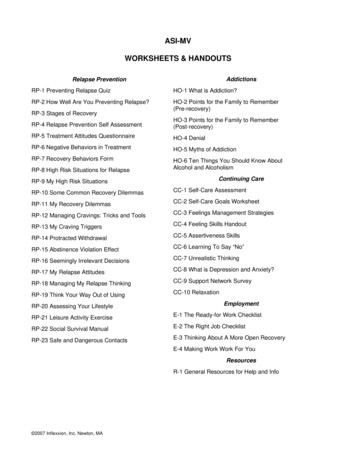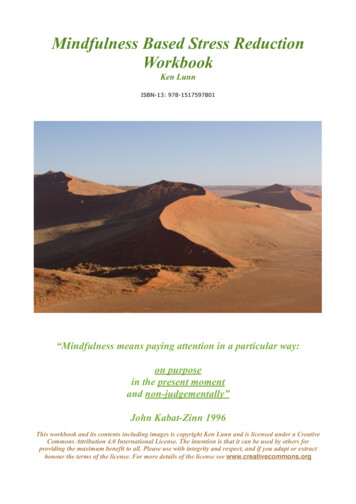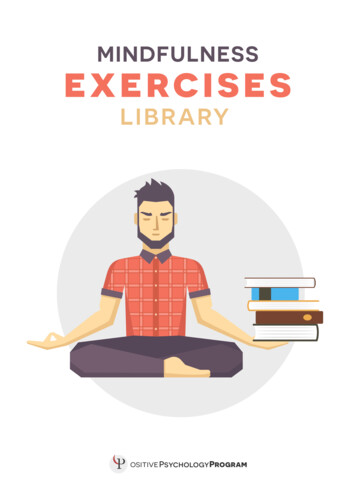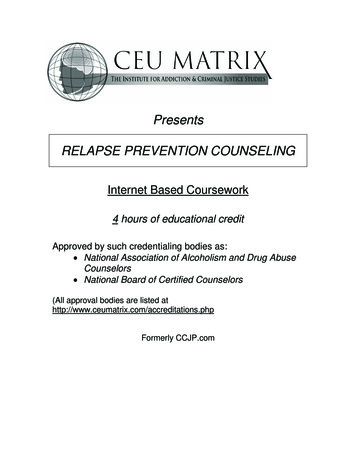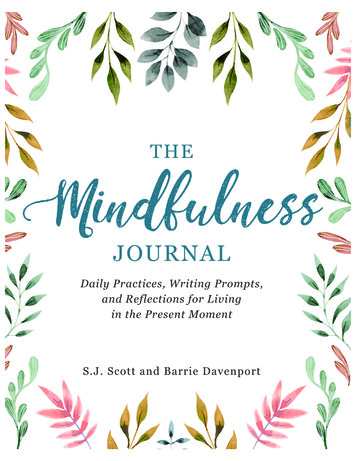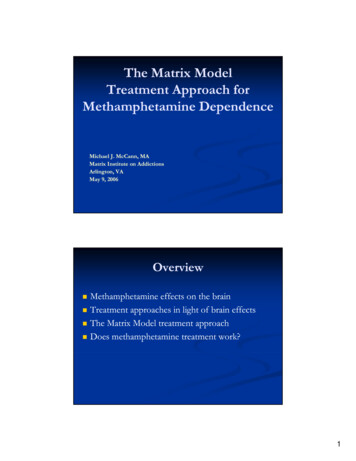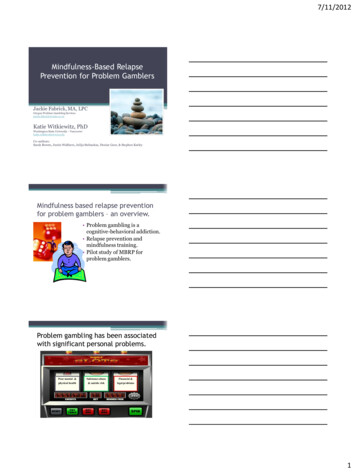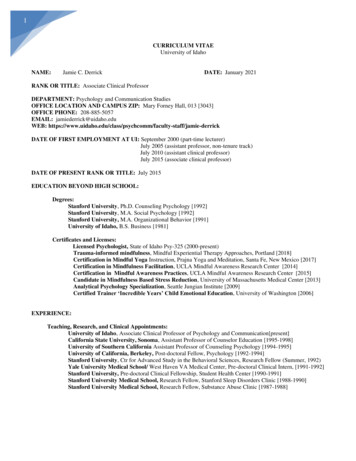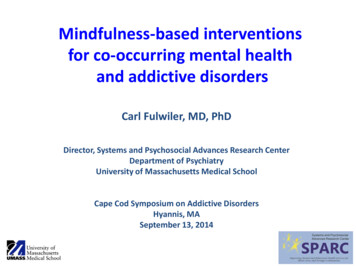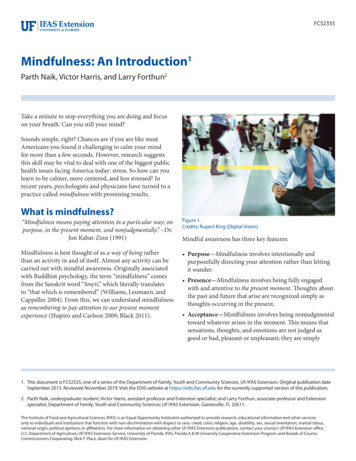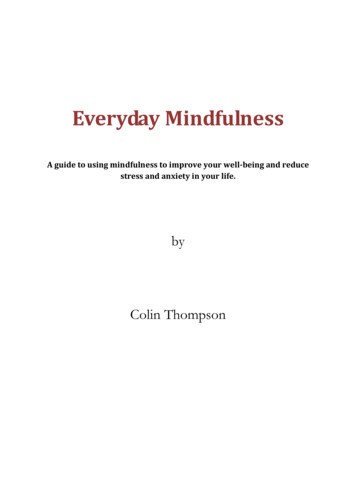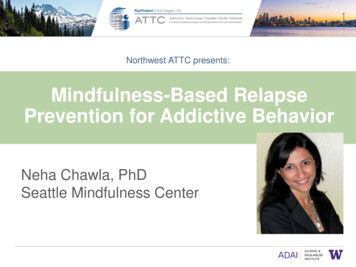
Transcription
Northwest ATTC presents:Mindfulness-Based RelapsePrevention for Addictive BehaviorNeha Chawla, PhDSeattle Mindfulness Center11/29/2018
Today’s PresenterNeha Chawla, PhD Founder & Director, SeattleMindfulness Center Co-creator, MBRP Co-author, Mindfulness-BasedRelapse Prevention for AddictiveBehavior: A Clinician’s Guide Group facilitator and trainer
Mindfulness-Based RelapsePrevention for Addictive BehaviorNeha Chawla, PhDSeattle Mindfulness omwww.MindfulRP.com
Road Map Why MBRP? What is Mindfulness? Why is it useful in treating addictivebehavior? MBRP: Content, Structure &Research
Road Map Why MBRP?
“Chronic relapsing conditions”65% to 90% have at least one drink in the first yearfollowing treatment, 50% in first 2 monthsImproved coping skills are related to less frequentdrinking at first lapse and lighter drinking thereafter(Maisto et al., 2003; Sutton, 1979; Witkiewitz & Masyn, 2008)
Relapse Prevention RP is an effective treatment for a range of substances(e.g., Alcohol, Cocaine, Marijuana, Smoking, Gambling, Eating) Does not always prevent a lapse better than othertreatments, but more effective at delaying, and alsoreducing duration and intensity of lapse(e.g., Irvin, et al., 1999; Carroll, 1996; Dimeff & Marlatt, 1998; Roffman, etal.1990; Schmitz, et al., 2001)
RP Mindfulness? Would the addition of mindfulness enhance theefficacy of RP? Can we integrate the two in a way that isaccessible/feasible? Are there individuals who would do better with analternative approach?
Road Map Why MBRP? What is Mindfulness?
American Mindfulness Research Association
What is Mindfulness?(Experiential Exercise)
(Attention)(Nonjudgmental)Chosen object(e.g., breath)Notice wandering,begin againAttentionWanders(Present Moment)
“Awareness that emerges through paying attention onpurpose, in the present moment, and non-judgmentally tothe unfolding of experience moment by moment”(Kabat-Zinn, 2003)
“Awareness that emerges through paying attention onpurpose, in the present moment, and non-judgmentally tothe unfolding of experience moment by moment”(Kabat-Zinn, 2003)
Road Map Why MBRP? What is Mindfulness? Why is it useful in treating addictivebehavior?
Mindfulness & Addictive Behavior PAYING ATTENTIONGreater awareness of triggers and reactions.Interrupting automatic behavior. PRESENT MOMENTAccepting present experience, rather thanescaping or avoiding it. NONJUDGMENTALLYDetach from self-critical and automatic thoughtsthat often lead to addictive behavior and relapse.
Mindfulness & Transtheoretical Model(Prochaska & DiClemente, 1983; Prochaska, DiClemente, & Norcross, 1992) CONTEMPLATIONGreater awareness of ambivalence/impact of changingvs. maintaining status quo; Greater ability to “be with”vs. “avoid” discomfort PREPARATIONIncreased awareness of triggers/seeing more clearlywhat needs to change and how ACTION Greater ability to respond vs. react/interrupthabitual behaviors/take skillful action MAINTENANCE Support continued awareness andchoice; minimize self-judgment
Mindfulness-Based Relapse Prevention
Structure and Format Patterned after MBSR (Kabat-Zinn) and MBCT(Segal et al.) 8 weekly 2-hour sessions; daily home practice Components Formal mindfulness practice Informal practice Coping strategies
Core Intentions AWARENESSThoughts, feelings and sensations, including triggers.Interrupt previously automatic/habitual behaviors RESPONDING VS. REACTINGGreater sense of freedom and choice RELATIONSHIP TO DISCOMFORT“Being with” rather than “fighting”, “avoiding” or “trying tofix” SELF-ACCEPTANCE/COMPASSIONRecognizing self-judgment and criticismRelating to experience with greater compassion LIFESTYLE BALANCESupporting a lifestyle that is aligned with recovery
Approach Experiential Present moment vs. story Importance of facilitator mindfulness practice:Nonjudgment, openness, curiositySimilar to MI Spirit: collaborative, accepting, compassionate andevocative. Elicit vs. teach‘Evoking’ in MI speak: The resources and motivation forchange are presumed to lie within the person.
Inquiry“I can’t do this”,“What’s wrong with me?”“I need a drink”Stories, JudgmentsRaw, DirectExperiencePain in the knee,feeling of sadness Relationship to RelapseAdapted from Segal et al., 2002 Not personal; a humanexperience
Session ThemesSession 1: Automatic Pilot and RelapseSession 2: Awareness of Triggers and CravingSession 3: Mindfulness in Daily LifeSession 4: Mindfulness in High-Risk SituationsSession 5: Acceptance and Skillful ActionSession 6: Seeing Thoughts as ThoughtsSession 7: Self-Care and Lifestyle BalanceSession 8: Social Support and ContinuingPractice
Session ThemesSession 1: Automatic Pilot and RelapseSession 2: Awareness of Triggers and CravingSession 3: Mindfulness in Daily LifeSession 4: Mindfulness in High-Risk SituationsSession 5: Acceptance and Skillful ActionSession 6: Seeing Thoughts as ThoughtsSession 7: Self-Care and Lifestyle BalanceSession 8: Social Support and ContinuingPracticeIncreasingAwareness
Session ThemesSession 1: Automatic Pilot and RelapseSession 2: Awareness of Triggers and CravingSession 3: Mindfulness in Daily LifeSession 4: Mindfulness in High-Risk SituationsSession 5: Acceptance and Skillful ActionSession 6: Seeing Thoughts as ThoughtsSession 7: Self-Care and Lifestyle BalanceSession 8: Social Support and ContinuingPracticeHigh-RiskSituations/Relapse
Session ThemesSession 1: Automatic Pilot and RelapseSession 2: Awareness of Triggers and CravingSession 3: Mindfulness in Daily LifeSession 4: Mindfulness in High-Risk SituationsSession 5: Acceptance and Skillful ActionSession 6: Seeing Thoughts as ThoughtsSession 7: Self-Care and Lifestyle BalanceSession 8: Social Support and ContinuingPracticeSelfCare/Maintenance
Formal Practices Body Scan Sitting Meditation Mountain Meditation Loving-kindness Meditation
Informal Practices Urge Surfing Mindfulness of Daily Activities SOBER Breathing Space Mindful Movement
Working with Urges & CravingRiding the WaveUrge Surfing: Staying with the urge (wave)as it grows, riding it to its peak, using thebreath to stay steady, trusting it willnaturally subside without any action.Seems as though the craving will get BIGGER and BIGGER Unless you do something to “fix it”
urgetime
SOBER Breathing SpaceS: StopO: ObserveB: BreathE: ExpandR: Respond
Cognitive-Behavioral Exercises Noticing Triggers Relapse Chain
Awareness of TriggersSituation/TriggerAnargumentwith mygirlfriend.Whatsensations didyouexperience?Tightnessin chest,sweatypalms,heartbeatingfast, shakyall overWhatWhatmoods,thoughtsfeelings orarose?emotions didyou notice?Anxiety,hurt,angerWhat didyou do?“I can’t do Yelled,this.”slammed“I need adrink.”“Forget it.I don’tcareanymore”door, wentfor a walk
Relapse ChainSTOPTriggerObserveReactionRespond w/AwarenessInitialReactionAutomaticPilotReact ReactionsBelievethoughtsRelapse
Research
MBRP Pilot StudyCompletedInpatient orIntensiveOutpatientN 168MBRPBaseline8 weeksPostCourse2monthsTAUFunded by National Institute on Drug Abuse Grant R21DAO 10562-01A1; PI: G. Alan Marlatt4months
Participants Age 40.5 (10.3); 64% male Ethnicity 50% Caucasian28% African American15% Multiracial7% Native American 72% completed high-school 41% unemployed 33% public assistance 62% less than 4,999 / year Homeless/unstably housed(Bowen et al., 2009)
Results Increased awareness and acceptance (p .01) Reduction in craving (p .05) Decreased rates of substance use (p .05) Effect of treatment on substance use mediated byreduction in craving Weaker relationship between depressive symptoms andcraving for MBRP group
Negative AffectOutcomesSubstance use treatment outcomes(e.g., Hodgins, el Guebaly, & Armstrong, 1995)Re-initiation of use following abstinence(e.g., Witkiewitz & Villarroel, 2009)Comorbidity 40% of Americans with depressive/anxietydisorders have co-occurring substance use disorders(NCS; Kessler, Nelson, McGonagle, Liu, et al., 1996)Depression has particularly strong relation with cravingand relapse(Gordon et al., 2006; Zilberman et al., 2007; Curran et al., 2000 ; Levy, 2008)
(e.g., Cleveland & Harris, 2010;Cooney, et al., 1997; Perkins & Grobe,1992; Shiffman & Waters, 2004; SinhaAwareness/acceptance& O’Malley, 1999; Stewart, 2000;of affectiveWheeler et discomfortal., 2008)(e.g., Hartz, et al., 2001; Hopperet al. 2006; Shiffman et al.,2002)Over time, cravingresponse in the presenceof negative affect eses:“Staying with” etween depressioncraving1985)in MBRP groupescapingrelationshipor “fixing”- Thereby reducingsubstanceuse in ler,1948) symptoms
TAUDepressiveSymptoms(Moderatedmediation effect oftreatment; p 0.04)MBRPCravingSubstanceUse
Results: Depression and CravingSubstanceUse
Larger MBRP TrialMBRPBaselineN 286RPPost3m6mTAU8 weeksFunded by National Institute on Drug Abuse Grant PI: Sarah Bowenyear
Results3 Months: No differences6 Months: MBRP and RP (vs. TAU) Higher probability of abstinence from drug use & notengaging in heavy drinking Among those who drank, 31% fewer days of heavy drinking RP (vs. MBRP) Longer time to first use
Results12 Months: MBRP (vs. RP & TAU) Higher probability of not engaging in heavy drinking 31% fewer drug use days
Conclusions All treatments are equally effective at 3 months. Both MBRP and RP (compared to TAU) blunt the probabilityand severity of relapse at 6 months, with RP delaying time to firstdrug use. MBRP may have a more enduring effect beyond 6 months.Hypothesized mechanismOver time, and with greater exposure, participants may be betterable to recognize and tolerate craving and negative affect.
Resources MBRP websitewww.mindfulrp.com MBRP Trainings Vashon Island, Washington USA: June, 2019THANK YOU!
SurveysLook for our surveys in yourinbox!We’ll send two short surveys:one now, andone in a month.We greatly appreciate your feedback! Every survey we receive helps usto improve and develop our programming.11/29/201849
Q&A50Questions? Please type them inthe chat box!?11/29/2018
Upcoming EventsThank you for coming!Join us for our next webinar:Addressing High-risk Sexual BehaviorAmong People in SUD TreatmentMary Hatch-Maillette, PhDDecember 19, 2018, 12-1pm11/29/201851
Mindfulness in Daily Life. Session 4: Mindfulness in High-Risk Situations. Session 5: Acceptance and Skillful Action. Session 6: Seeing Thoughts as Thoughts. Session 7: Self-Care and Lifestyle B
